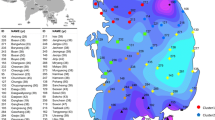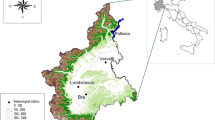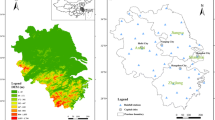Abstract
This paper considers a problem of analyzing temporal and spatial structure of particulate matter (PM) data with emphasizing high-level \(\text {PM}_{10}\). The proposed method is based on a combination of a generalized extreme value (GEV) distribution and a multiscale concept from scaling property theory used in hydrology. In this study, we use hourly \(\text {PM}_{10}\) data observed for 5 years on 25 stations located in Seoul metropolitan area, Korea. For our analysis, we calculate monthly maximum values for various duration times and area coverages at each station, and show that their distribution follows a GEV distribution. In addition, we identify that the GEV parameters of \(\text {PM}_{10}\) maxima hold a new scaling property, termed ‘piecewise linear scaling property’ for certain duration times. By using this property, we construct a 12-month return level map of hourly \(\text {PM}_{10}\) data at any arbitrary d-hour duration. Furthermore, we extend our study to understand spatio-temporal multiscale structure of \(\text {PM}_{10}\) extremes over different temporal and spatial scales.













Similar content being viewed by others
References
Blanchet J, Davison AC (2011) Spatial modeling of extreme snow depth. Ann Appl Stat 5:1699–1725
Ceresetti D, Anquetin S, Molinié G, Leblois E, Creutin J-D (2012a) Multiscale evaluation of extreme rainfall event predictions using severity diagrams. Weather Forecast 27:174–188
Ceresetti D, Ursu E, Carreau J, Anquetin S, Creutin J-D, Gardes L, Girard S, Molinie G (2012b) Evaluation of classical spatial-analysis schemes of extreme rainfall. Nat Hazards Earth Syst Sci 12:3229–3240
Coles S (2001) An introduction to statistical modeling of extreme values. Springer, New York
Cooley D, Cisewski J, Erhardt J, Jeon S, Mannshardt E, Omolo BO, Sun Y (2012) a survey of spatial extremes: measuring spatial dependence and modeling spatial effects. Revstat 10:135–165
Davison AC, Padoan SA, Ribatet M (2012) Statistical modeling of spatial extremes. Stat Sci 27:161–186
De Michele C, Kottegoda NT, Rosso R (2001) The derivation of areal reduction factor of storm rainfall from its scaling properties. Water Resour Res 37:3247–3252
Dey DK, Yan J (2015) Extreme value modeling and risk analysis: methods and applications. CRC Press, Boca Raton
Friedman JH (1991) Multivariate adaptive regression splines. Ann Stat 19:1–67
Gupta VK, Waymire E (1990) Multiscaling properties of spatial rainfall and river flow distribution. J Geophys Res 95:1999–2009
Heffernan JE, Stephenson AG (2016) ismev: an introduction to statistical modeling of extreme values. R package version 1.41. http://www.ral.ucar.edu/ericg/softextreme.php
Hosking JRM (1990) L-moments: analysis and estimation of distributions using linear combinations of order statistics. J R Stat Soc Ser B 52:105–124
Huser R, Davison AC (2014) Space-time modelling of extreme events. J R Stat Soc Ser B 76:439–461
Kim U, Kim J, Hong J (2014) A study on establishing \(\text{ PM }_{2.5}\) advisory criteria with emission source management system in Seoul (written in Korean). Research Report of The Seoul Institute, Seoul. http://www.si.re.kr/node/49968
Kim U, Kim J (2011) A study of building customized management strategies based on local \(\text{ PM }_{10}\) emission inventory in Seoul (written in Korean). Research Report of Seoul Development Institute, Seoul. http://www.si.re.kr/node/24705
Laio F (2004) Cramer-von Mises and Anderson-Darling goodness of fit tests for extreme value distributions with unknown parameters. Water Resour Res 40:W09308. doi:10.1029/2004WR003204
Lu H-C, Fang G-C (2003) Predicting the exceedances of a critical \(\text{ PM }_{10}\) concentration-a case study in Taiwan. Atmos Environ 37:3491–4399
Masseran N, Razall AM, Ibrahim K, Latif MT (2016) Modeling air quality in main cities of Peninsular Malaysia by using a generalized Pareto model. Environ Monit Assess 188:1–12
Menabde M, Seed A, Pegram G (1999) A simple scaling model for extreme rainfall. Water Resour Res 35:335–339
Nychka D, Furrer R, Paige J, Sain S (2016) Fields: tools for spatial data. R package version 8.4-1. http://www.image.ucar.edu/fields
Paciorek CJ, Yanosky JD, Puett RC, Laden F, Suh HH (2009) Practical large-scale spatio-temporal modeling of particulate matter concentrations. Ann Appl Stat 3:370–397
Padoan SA, Ribatet M, Sisson SA (2010) Likelihood-based inference for max-stable processes. J Am Stat Assoc 105:263–277
Panthou G, Vischel T, Lebel T, Blanchet J, Quantin G, Ali A (2012) Extreme rainfall in West Africa: a regional modeling. Water Resour Res. doi:10.1029/2012WR012052
Panthou G, Vischel T, Lebel T, Quantin G, Pugin A-C, Blanchet J, Ali A (2013) From pointwise testing to a regional vision: an integrated statistical approach to detect nonstationarity in extreme daily rainfall. Application to the Sahelian region. J Geophys Res: Atmos 118:8222–8237
Qin S, Liu F, Wang C, Song Y, Qu J (2015) Spatial-temporal analysis and projection of extreme particulate matter (\(\text{ PM }_{10}\) and \(\text{ PM }_{2.5}\)) levels using association rules: a case study of the **g-**-Ji region, China. Atmos Environ 120:339–350
Rodríguez R, Navarro X, Casas MC, Redaño A (2013) Rainfall spatial organization and areal reduction factors in the metropolitan area of Barcelona (Spain). Theor Appl Climatol 114:1–8
Van de Vyver H (2015) On the estimation of continuous 24-h precipitation maxima. Stoch Environ Res Risk Assess 29:653–663
World Health Organization (2006) Air quality guidelines: global update 2005: particulate matter, ozone, nitrogen dioxide, and sulfur dioxide. p 12. http://apps.who.int/iris/bitstream/10665/69477/1/WHO_SDE_PHE_OEH_06.02_eng
Yanosky JD, Paciorek CJ, Laden F, Hart JE, Puett RC, Liao D, Suh HH (2014) Spatio-temporal modeling of particulate air pollution in the conterminous United States using geographic and meteorological predictors. Environ Health. doi:10.1186/1476-069X-13-63
Yoon P, Kim T-W, Yoo C (2013) Rainfall frequency analysis using a mixed GEV distribution: a case study for annual maximum rainfalls in South Korea. Stoch Environ Res Risk Assess 27:1143–1153
Acknowledgements
This paper is based on author’s report awarded at “The Seoul Institute Research Competition 2015” and the data provided by The Seoul Institute. This work was supported in part by the National Research Foundation of Korea (NRF) Grant funded by the Korea government (MSIP) (Nos. 20110030811 and 2015R1D1A1A01056854).
Author information
Authors and Affiliations
Corresponding author
Appendices
Appendix 1: scaling property theory
Scaling property is widely used in multiscale rainfall analysis, which explains the relation between \(Y_{d}(x)\) and \(Y_{d_{ref}}(x)\). We consider a nonnegative random variable Y only. Evenly-time-spaced climate data including \(\text {PM}_{10}\) extremes have their own reference observational time such as a hour, a month, etc. In this paper, the reference time is considered as a hour since the \(\text {PM}_{10}\) data are observed at every hour. Let \(Z_{d}(x)\) be a maximum of \(Y_{d}(x)\), d hour duration \(\text {PM}_{10}\) density at location x. We are interested in the distribution of \(Z_{d}(x)\). When the information of the distribution is known, we have the information about quantiles of \(Z_{d}(x)\); hence, we could compute the extreme \(\text {PM}_{10}\) intensity at any observation location and/or duration time.
On the other hand, a wide-sense scaling property between \(Y_{d_{ref}}(x)\) and \(Y_{d}(x)\) is expressed by the following equation (Gupta and Waymire 1990; Menabde et al. 1999)
where \(\frac{d}{d_{ref}}\) is a scaling factor and \(\nu \) is a scaling exponent. The meaning of this simple scaling property is that \((\frac{d}{d_{ref}})^{-\nu }Y_{d_{ref}}(x)\) and \(Y_{d}(x)\) are equal in distribution. Thus, if we know the distribution of \(Y_{d_{ref}}(x)\), the scaling factor and the scaling exponent, then it is able to obtain the distribution of \(Y_{d}(x)\) as well. This property also holds for \(Z_{d}(x)\), that is,
The role of the scaling exponent can be interpreted as follows. When the scaling exponent is less than zero, \(d>d_{ref}\) implies \(Z_{d}(x)>Z_{d_{ref}}(x)\), while when the scaling exponent is bigger than zero, \(d<d_{ref}\) indicates \(Z_{d}(x)<Z_{d_{ref}}(x)\).
On the other hand, a strict-sense scaling property is defined by cumulative distribution function (CDF) of Y, F
where \(F_{Y_{d}}\) and \(F_{Y_{d_{ref}}}\) are CDFs of GEV (\(\mu _{d}, \sigma _{d}, \xi _{d}\)) and GEV (\(\mu _{d_{ref}}, \sigma _{d_{ref}}, \xi _{d_{ref}}\)), respectively. With the assumption of \(\xi _{d}=\xi _{d_{ref}}=\xi \), we derive the following scaling equation between GEV parameters from (8)
which is used for estimating \(\mu _{d}\) and \(\sigma _{d}\) from \(\mu _{d_{ref}}\), \(\sigma _{d_{ref}}\) and \(\nu \).
Appendix 2: generalized extreme value distribution
GEV distribution is known that it is suitable for fitting blockwise extreme value distribution such as a distribution of monthly \(\text {PM}_{10}\) maxima. The probability density function (PDF) of GEV distribution is defined as
where
Here \(\mu \), \(\sigma \), \(\xi \) denote location, scale and shape parameters, respectively. The corresponding CDF is
The location and scale parameters of GEV have similar roles with those in normal distribution. The sign of the shape parameter decides GEV family types. Figure 14 shows the three types of GEV class by changing sign of the shape parameter: when the sign is zero, it is called Gumbel family, when the sign is positive, it is called Fréchet family, and when the sign is negative, it is called Weibull family. Note that for computation of GEV, we use maximum likelihood fitting for GEV in R package ismev of Heffernan and Stephenson (2016).
Rights and permissions
About this article
Cite this article
Park, S., Oh, HS. Spatio-temporal analysis of particulate matter extremes in Seoul: use of multiscale approach. Stoch Environ Res Risk Assess 31, 2401–2414 (2017). https://doi.org/10.1007/s00477-016-1376-6
Published:
Issue Date:
DOI: https://doi.org/10.1007/s00477-016-1376-6





